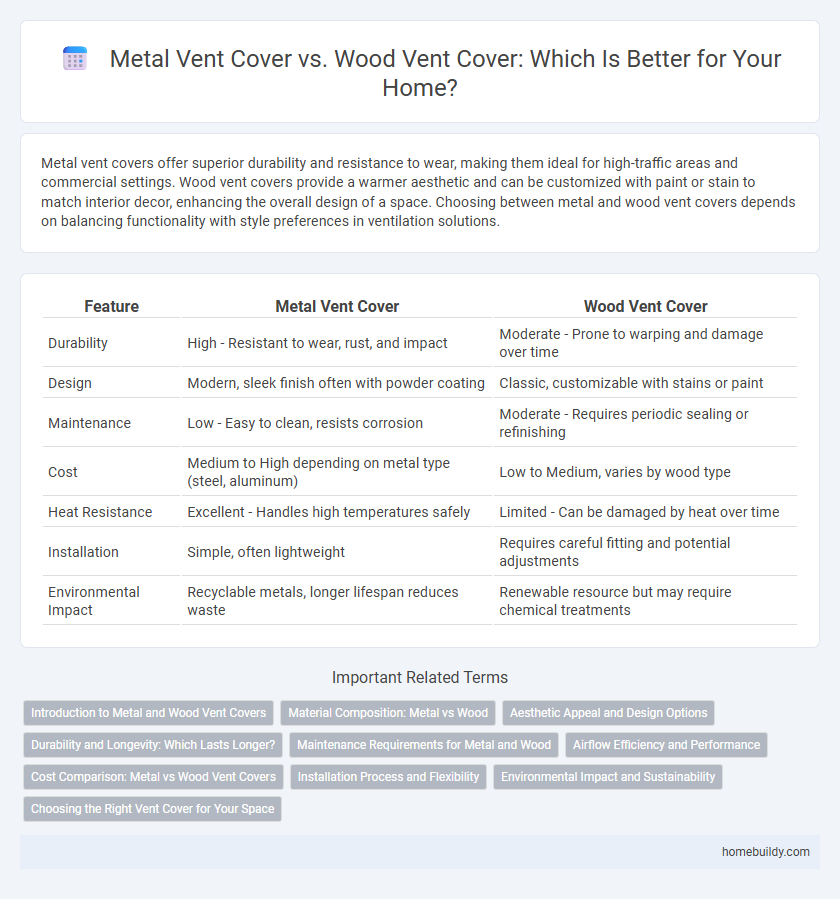Metal vent covers offer superior durability and resistance to wear, making them ideal for high-traffic areas and commercial settings. Wood vent covers provide a warmer aesthetic and can be customized with paint or stain to match interior decor, enhancing the overall design of a space. Choosing between metal and wood vent covers depends on balancing functionality with style preferences in ventilation solutions.
Table of Comparison
| Feature | Metal Vent Cover | Wood Vent Cover |
|---|---|---|
| Durability | High - Resistant to wear, rust, and impact | Moderate - Prone to warping and damage over time |
| Design | Modern, sleek finish often with powder coating | Classic, customizable with stains or paint |
| Maintenance | Low - Easy to clean, resists corrosion | Moderate - Requires periodic sealing or refinishing |
| Cost | Medium to High depending on metal type (steel, aluminum) | Low to Medium, varies by wood type |
| Heat Resistance | Excellent - Handles high temperatures safely | Limited - Can be damaged by heat over time |
| Installation | Simple, often lightweight | Requires careful fitting and potential adjustments |
| Environmental Impact | Recyclable metals, longer lifespan reduces waste | Renewable resource but may require chemical treatments |
Introduction to Metal and Wood Vent Covers
Metal vent covers offer superior durability and resistance to moisture, making them ideal for high-humidity areas and long-lasting use. Wood vent covers provide a classic, aesthetic appeal with customizable finishes, blending seamlessly into traditional or rustic interiors. Choosing between metal and wood vent covers depends on balancing durability requirements with design preferences and environmental conditions.
Material Composition: Metal vs Wood
Metal vent covers are typically made from durable materials such as steel or aluminum, offering superior resistance to heat and moisture compared to wood. Wood vent covers, constructed from hardwoods like oak or maple, provide aesthetic warmth but are more susceptible to warping and damage in humid environments. The choice between metal and wood largely depends on environmental exposure and desired longevity, with metal excelling in durability and wood favored for decorative appeal.
Aesthetic Appeal and Design Options
Metal vent covers offer a sleek, modern aesthetic with options including brushed steel, aluminum, and copper finishes that complement contemporary interiors. Wood vent covers provide a warm, natural look with customizable stains and intricate carvings ideal for traditional or rustic decor. Both materials offer diverse design choices, but metal suits minimalist styles while wood enhances classic and cozy environments.
Durability and Longevity: Which Lasts Longer?
Metal vent covers exhibit superior durability compared to wood vent covers due to their resistance to warping, cracking, and moisture damage. They typically last 15 to 20 years or more with minimal maintenance, whereas wood vent covers often succumb to environmental wear within 5 to 10 years. The enhanced corrosion resistance and structural integrity of metal make it a longer-lasting choice for vent covers in both residential and commercial applications.
Maintenance Requirements for Metal and Wood
Metal vent covers require minimal maintenance due to their resistance to moisture, rust, and warping, typically needing only occasional cleaning with a damp cloth to prevent dust buildup. Wood vent covers demand more frequent upkeep, including periodic sanding and refinishing to address potential warping, cracking, or paint peeling caused by humidity and temperature changes. Regular inspection of wood vent covers is essential to maintain their appearance and functionality, whereas metal covers offer greater durability with less effort.
Airflow Efficiency and Performance
Metal vent covers provide superior airflow efficiency compared to wood vent covers due to their precision-engineered slots and durable construction, which minimize obstructions and enhance ventilation performance. Wood vent covers, while aesthetically pleasing, often have thicker slats and may warp over time, leading to reduced airflow and compromised HVAC system effectiveness. Choosing metal vent covers ensures optimal air distribution and maintains consistent indoor air quality.
Cost Comparison: Metal vs Wood Vent Covers
Metal vent covers typically cost between $10 to $50 depending on size and design, offering durability and low maintenance that justify the initial investment. Wood vent covers range from $20 to $100, with higher prices reflecting custom craftsmanship and aesthetic appeal but require more upkeep and potential refinishing. Choosing metal offers long-term savings due to resistance to warping and environmental damage, while wood can increase upfront costs and maintenance expenses over time.
Installation Process and Flexibility
Metal vent covers offer straightforward installation with pre-drilled holes and durable materials, enabling quick mounting and long-term stability, while wood vent covers require precise measurements and potentially more complex customization for fitting irregular spaces. Metal covers provide superior flexibility by accommodating various duct sizes and shapes without modification, whereas wood covers may need trimming or additional carpentry work to ensure a proper fit. Choosing metal vent covers enhances installation efficiency and adaptability, reducing labor time and minimizing adjustments compared to wood options.
Environmental Impact and Sustainability
Metal vent covers typically have a higher environmental footprint due to energy-intensive mining and manufacturing processes, yet they often offer superior durability and recyclability, extending their lifecycle impact. Wood vent covers, while renewable and biodegradable, may contribute to deforestation and require chemical treatments that affect sustainability. Evaluating environmental impact involves balancing metal's recyclability against wood's natural renewability and potential ecological consequences.
Choosing the Right Vent Cover for Your Space
Metal vent covers offer superior durability and heat resistance, making them ideal for high-traffic areas and rooms with heating vents. Wood vent covers provide a customizable and aesthetically pleasing option, perfect for matching interior decor but require regular maintenance to prevent warping or damage from moisture. Choosing the right vent cover depends on balancing functional needs such as airflow and heat tolerance with design preferences and room conditions.
metal vent cover vs wood vent cover Infographic

 homebuildy.com
homebuildy.com